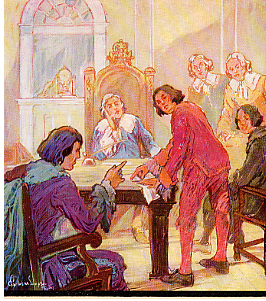
|
|
| Date Published: |
L’Encyclopédie de l’histoire du Québec / The Quebec History Encyclopedia
Compagnie des Habitants(1645)
Compagnie des Habitants. The Compagnie des Habitants (or Communauté des Habitants, as both names can be used) was formed in 1645, in Quebec. Its promoters were Pierre Le Gardeur de Repentigny, François de Chavigny, Noël Juchereau des Châtelets, Jacques Leneuf de la Potherie, Michel Leneuf du Hérisson, Guillaume Couillard, Jean Paul Godefroy, Jean Bourdon, Mathurin Gagnon, and Jean Guyon. In 1645, thanks to the influence of the Jesuits at court, it obtained from the Company of New France the transfer of its trade monopoly, outside Acadia, on condition of assuming all the administrative, military, and religious charges of the colony, as well as the yearly transportation of 20 colonists, and an annual payment of one thousand beaver skins. This agreement was confirmed by a royal edict of March 6, 1645.
The company was open to all the inhabitants, divided into three classes: the important men, the middle-class citizens and the common people. Profits were to be divided equally among members of each class, but unequally among the classes, and directors were elected by the members. As a matter of fact, the company was composed of the better-off families of the colony.
In a small country of about 500 souls, the company had to borrow all its capital, mostly in France, at very high interest. During the first years, the monopoly proved profitable, but in face of the directors' extravagance, the King in March, 1647, appointed to take their place a council consisting of the governor, the superior of the Jesuits, and the governor of Montreal, and this council was entrusted with the necessary trade and financial administration. At the same time, the fur barter was thrown open to every one, on condition of taking the skins to the company's stores at Quebec or Three Rivers. By a decree of March, 1648, while the European trade was also made free, the council was reformed so as to include two inhabitants selected by the permanent councillors, and later, in 1657, was again remodeled so as to include four councillors elected by the inhabitants of Quebec, Three Rivers, and Montreal.
Scene, as drawn by Charles W. Simpson, of the first meeting of the Council elected in 1657.
After the dispersion of the Hurons by the Iroquois, the fur-trade suffered a sudden collapse. The company soon found great difficulty in defraying the colonial budget of about 40,000 livres a year. In 1652, a duty amounting to half the beaver traded was imposed, but was reduced to one-fourth the following year, and the Tadoussac territory trade was leased out for a lump sum. Nevertheless, the company was obliged, in 1653, to suspend the annual shipment of the 1,000 beaver skins to the Company of New France and to secure from the king, in 1655, a five-year moratorium of its debts. All these measures proving insufficient, in spite of an additional duty of one-tenth on moose skins, it offered, but vainly, to give up its monopoly. The situation not improving, it was forced, in 1658, again to lease for 9,000 livres the Tadoussac trade. Two years later, in order to rescue the company, a new duty of 10 per cent. was imposed on all imported goods, and farmed for 10,000 livres to Aubert de la Chesnaye. Yet, in February, 1660, the company had to sublet for four years its fur monopoly to a French company, headed by Toussaint Guenet, agreeing to pay 10,000 livres a year to extinguish the Community's debts, as well as 50,000 livres in exchange of the moose and beaver duty, but this agreement was cancelled by the king in 1662. Then the Tadoussac trade was again leased and the 10 per cent. duty sublet the same year by Governor D'Avaugour himself.
In 1663, with the suppression of the Company of New France, the Communauté des Habitants ceased to exist, but the king allowed the 10 per cent. collected on importation to be applied to the discharge of its debt. This debt was estimated at 163,000 livres, and seems to have been repaid, but very slowly, through a long period of years.
See G. Lanctot, The elective council of Quebec (Can. hist. rev., June, 1934). Source : W. Stewart WALLACE, ed., The Encyclopedia of Canada, Vol. II, Toronto, University Associates of Canada, 1948, 411p., p. 109-111.
|
© 2005
Claude Bélanger, Marianopolis College |
|
